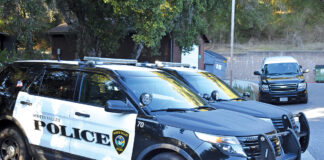A long-debated flight path shift from one part of the county to another is in design phase according to Federal Aviation Administration (FAA) representatives. The current path, called SERFR, has been in place since the FAA rolled out their NextGen initiative in March 2015. NextGen is a realignment of airspace that purports to increase safety and predictability, reduce fuel consumption, and supports anticipated increases in traveler capacity. The SERFR path carries 180+ airplanes each day, all funneled into a concentrated corridor. This increased concentration and frequency has caused discomfort for residents under the path in Santa Cruz County with complaints to the SFO Aircraft Noise Abatement Office tallying in the hundreds of thousands.
The SERFR path enters the coast at Capitola, flies over Soquel, Happy Valley and a northeastern section of Scotts Valley. Summit area residents were particularly impacted as the SERFR configuration lowered altitudes and narrowed the path. Representatives of those communities including former congressman Sam Farr, current Rep. Jimmy Panetta and Supervisor John Leopold have lobbied fiercely for moving SERFR 3 miles to the west toward a legacy path called BSR that is in use currently only for non-GPS navigation aircraft.
This shift toward BSR will bring new jet noise, 180+ airplanes each day, to the City of Santa Cruz, Scotts Valley, Pasatiempo, and the San Lorenzo Valley with vectored flights (those in a holding queue for SFO) to affect other communities to the west including Bonny Doon.
The Santa Clara/Santa Cruz Roundtable, a membership body open to the counties of Santa Clara and Santa Cruz and their cities, was convened with the mission of addressing jet noise issue for its member representatives. The majority of the members of this body reside near the SERFR path and represent constituents under SERFR path. Their comments on the roundtable indicate support for the path shift as a way to alleviate the suffering of residents under SERFR. The discussions of the Roundtable currently center around geography and politics rather than data, noise metrics and analytics to measure noise. And it has not addressed the impact to residents potentially impacted by a new path. Capitola city councilmember Ed Bottorff stated at the June 26 meeting that mitigations are “considerations, not conditions.” This statement contravenes a congressionally organized Select Committee which confirmed that a path shift must be accompanied by prerequisite and mandatory criteria in order to protect SLV and Scotts Valley residents exposed to new airplane traffic.
There are no aviation experts on the Roundtable, which is comprised of elected officials, with the exception of Santa Cruz County representative Carlos Palacios, the County Administrative Officer, who is an appointed official. Palacios confirmed that he supports the residents under SERFR in their quest to move the path. Speaking to FAA representative Favi Garcia at the June meeting, Palacios said, “I would just urge you to expedite this process as much as possible. This is clearly a crisis in this community. We hear from these folks all the time because they are under a great deal of stress and pressure. So, anything you can do to expedite the process we would greatly appreciate.” Palacios’ advocacy for the path shift leaves the San Lorenzo Valley, Pasatiempo, and the majority of Scotts Valley without an advocate on the Roundtable.
However, 5th District Supervisor Bruce McPherson said, “In multiple letters to the FAA and our Congressional representatives, I have consistently urged action to meaningfully address the impacts of NextGen procedures without simply moving jet noise from one part of the county to another. Those under the current path shouldn’t have to suffer and we need evidence that the FAA won’t just move the noise to another path.”
This is the first in a series of articles on the impact to residents under the SERFR path and the implications of the BSR path to Santa Cruz Mountains residents. Contact pb******@*********er.com with your perspective.












